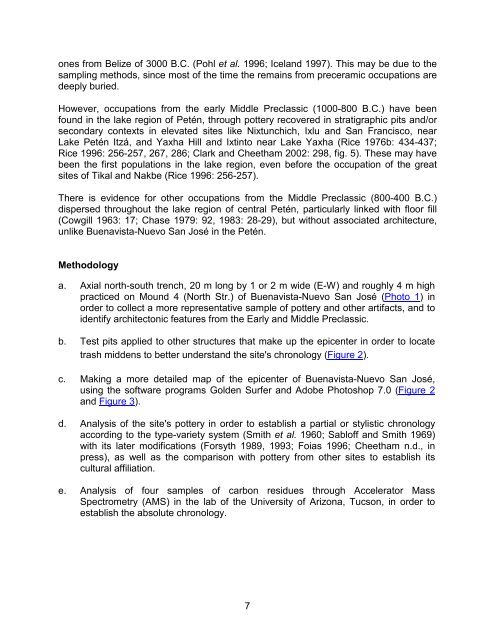Buenavista-Nuevo San José, Petén, Guatemala: Another ... - Famsi
Buenavista-Nuevo San José, Petén, Guatemala: Another ... - Famsi
Buenavista-Nuevo San José, Petén, Guatemala: Another ... - Famsi
Create successful ePaper yourself
Turn your PDF publications into a flip-book with our unique Google optimized e-Paper software.
ones from Belize of 3000 B.C. (Pohl et al. 1996; Iceland 1997). This may be due to the<br />
sampling methods, since most of the time the remains from preceramic occupations are<br />
deeply buried.<br />
However, occupations from the early Middle Preclassic (1000-800 B.C.) have been<br />
found in the lake region of <strong>Petén</strong>, through pottery recovered in stratigraphic pits and/or<br />
secondary contexts in elevated sites like Nixtunchich, Ixlu and <strong>San</strong> Francisco, near<br />
Lake <strong>Petén</strong> Itzá, and Yaxha Hill and Ixtinto near Lake Yaxha (Rice 1976b: 434-437;<br />
Rice 1996: 256-257, 267, 286; Clark and Cheetham 2002: 298, fig. 5). These may have<br />
been the first populations in the lake region, even before the occupation of the great<br />
sites of Tikal and Nakbe (Rice 1996: 256-257).<br />
There is evidence for other occupations from the Middle Preclassic (800-400 B.C.)<br />
dispersed throughout the lake region of central <strong>Petén</strong>, particularly linked with floor fill<br />
(Cowgill 1963: 17; Chase 1979: 92, 1983: 28-29), but without associated architecture,<br />
unlike <strong>Buenavista</strong>-<strong>Nuevo</strong> <strong>San</strong> <strong>José</strong> in the <strong>Petén</strong>.<br />
Methodology<br />
a. Axial north-south trench, 20 m long by 1 or 2 m wide (E-W) and roughly 4 m high<br />
practiced on Mound 4 (North Str.) of <strong>Buenavista</strong>-<strong>Nuevo</strong> <strong>San</strong> <strong>José</strong> (Photo 1) in<br />
order to collect a more representative sample of pottery and other artifacts, and to<br />
identify architectonic features from the Early and Middle Preclassic.<br />
b. Test pits applied to other structures that make up the epicenter in order to locate<br />
trash middens to better understand the site's chronology (Figure 2).<br />
c. Making a more detailed map of the epicenter of <strong>Buenavista</strong>-<strong>Nuevo</strong> <strong>San</strong> <strong>José</strong>,<br />
using the software programs Golden Surfer and Adobe Photoshop 7.0 (Figure 2<br />
and Figure 3).<br />
d. Analysis of the site's pottery in order to establish a partial or stylistic chronology<br />
according to the type-variety system (Smith et al. 1960; Sabloff and Smith 1969)<br />
with its later modifications (Forsyth 1989, 1993; Foias 1996; Cheetham n.d., in<br />
press), as well as the comparison with pottery from other sites to establish its<br />
cultural affiliation.<br />
e. Analysis of four samples of carbon residues through Accelerator Mass<br />
Spectrometry (AMS) in the lab of the University of Arizona, Tucson, in order to<br />
establish the absolute chronology.<br />
7
















